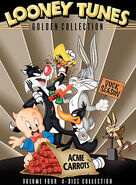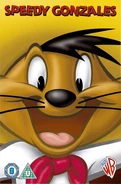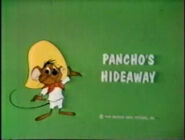Pancho's Hideaway is a 1964 Looney Tunes short directed by Friz Freleng and Hawley Pratt.
Plot[]
Bandit Pancho Vanilla rides his horse and robs a bank in Mexico, leaving the town in poverty. He hurries back to his hideout to see how much he stole. In the town hall, Speedy Gonzales comes up to Manuel in a mousehole. Manuel thinks that having the town become poor is a good thing since all of the cats will be thrown out, but Speedy says that isn't good. Speedy intends to return the money because poverty will cause people to eat all the crumbs, leaving the mice with nothing to eat. Manuel agrees with Speedy, and Speedy runs to Pancho's hideout.
Speedy interrupts Pancho's coin counting and challenges him to a duel. During the duel, Speedy is able to return a coin by going through his legs, while Pancho shoots his own feet trying to blast Speedy. Pancho attempts many traps to stop Speedy from stealing the rest of his stash:
- Pancho hides a landmine for Speedy to run past so it will explode on the rodent. However, Speedy appears from behind and yells "Yeehaw," scaring Pancho onto the landmine, blowing it up.
- Pancho creates a mousehole trap with a rifle inside. Speedy runs through the barrel and gives Pancho the bullet he was going to shoot Speedy with. The bullet explodes in Pancho's face.
- Pancho assembles a gun mechanism connected to an electric eye. Speedy sees the electric eye and tries to lure Pancho to it by convincing him that he can get his coins back if he collects them from Speedy. Pancho steps right in front of the electric eye and is blasted.
Speedy takes all the money back to the bank and counts the coins. A defeated Pancho sneaks in from behind and has the last laugh by yelling "Yeehaw," interrupting Speedy's progress. Annoyed, Speedy begins to count the coins all over again.
Availability[]
Looney Tunes Golden Collection: Volume 4, Disc Three (restored)
Speedy Gonzales
Streaming[]
Notes[]
- This was the first Looney Tunes short to be produced by the DePatie-Freleng Enterprises studio.
- David H. DePatie and Friz Freleng receive onscreen credit as producers for the first time, marking the first cartoon in twenty years since the Leon Schlesinger era where Looney Tunes cartoon producers receive onscreen credit, and the first cartoon to do so since "Buckaroo Bugs" (1944).
- Pancho Vanilla resembles Yosemite Sam with a Mexican accent.
- He shares a name with a short and its protagonist Little Pancho Vanilla that also takes place in Mexico.
- While some people think he is meant to be an alternate interpretation of Yosemite Sam, with some unofficial websites listing him as an official depiction of Sam, he may just be a one-off character who looks and acts like him, as it is not unusual for popular cartoon characters to have "clones".
- Some evidence leaning more towards him being a "clone" of Yosemite Sam is no matter what setting, Sam either keeps his name or something similar to it and/or has the same physical design but in a different outfit. Pancho Vanilla has brunette hair instead of red hair and lacks a mask, two things Sam always keeps in his varying designs no matter what setting.
- As this is the first short after the original studio closed, it retains the opening and closing from the studio's final short, "Señorella and the Glass Huarache", which used the "Abstract" WB opening from "Now Hear This" originally used for one-shot cartoons, although the chimes of Big Ben at the end are replaced by an abridged reprise of the opening theme. All future Looney Tunes and Merrie Melodies shorts produced until 1969 would feature this opening sequence, although the background is changed from white to black immediately afterward.
- The Merrie Melodies Show version of this cartoon's title card (pictured in the "Gallery" below) depicts Speedy Gonzales and Yosemite Sam.
- Some of the animation, particularly the scene of Speedy coming out of the hole, was reused animation taken from "Mexican Boarders" (1962).
- This is one of only two Friz Freleng cartoons in The Golden Age of Animation to star Speedy without Sylvester, the other one being "Mexicali Shmoes".
Gallery[]
TV Title Cards[]
References[]
| Speedy Gonzales Cartoons | ||||
|---|---|---|---|---|
| 1953 | Cat-Tails for Two | |||
| 1955 | Speedy Gonzales | |||
| 1957 | Tabasco Road • Gonzales' Tamales | |||
| 1958 | Tortilla Flaps | |||
| 1959 | Mexicali Shmoes • Here Today, Gone Tamale | |||
| 1960 | West of the Pesos | |||
| 1961 | Cannery Woe • The Pied Piper of Guadalupe | |||
| 1962 | Mexican Boarders | |||
| 1963 | Mexican Cat Dance • Chili Weather | |||
| 1964 | A Message to Gracias • Nuts and Volts • Pancho's Hideaway • Road to Andalay | |||
| 1965 | It's Nice to Have a Mouse Around the House • Cats and Bruises • The Wild Chase • Moby Duck • Assault and Peppered • Well Worn Daffy • Chili Corn Corny • Go Go Amigo | |||
| 1966 | The Astroduck • Mucho Locos • Mexican Mousepiece • Daffy Rents • A-Haunting We Will Go • Snow Excuse • A Squeak in the Deep • Feather Finger • Swing Ding Amigo • A Taste of Catnip | |||
| 1967 | Daffy's Diner • Quacker Tracker • The Music Mice-Tro • The Spy Swatter • Speedy Ghost to Town • Rodent to Stardom • Go Away Stowaway • Fiesta Fiasco | |||
| 1968 | Skyscraper Caper • See Ya Later Gladiator | |||
| 1979 | Fright Before Christmas | |||
| 1980 | The Chocolate Chase | |||



























